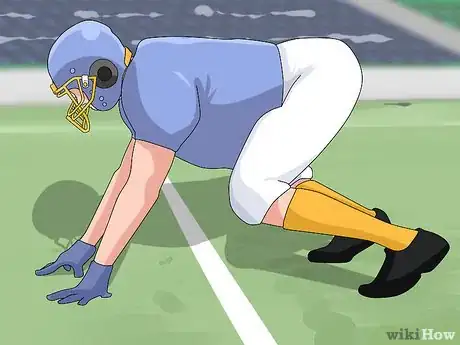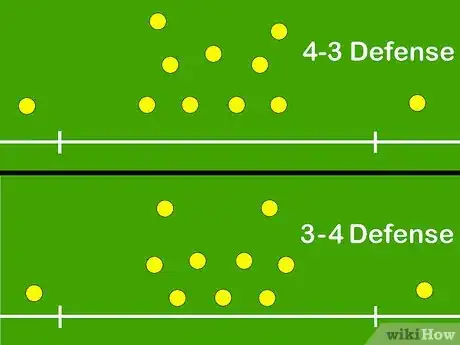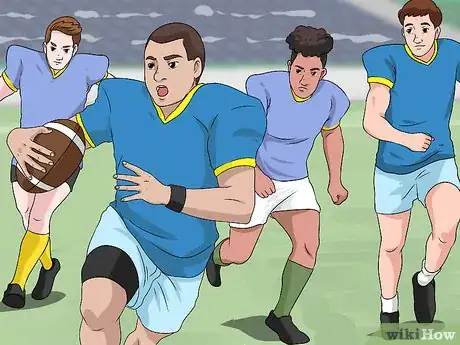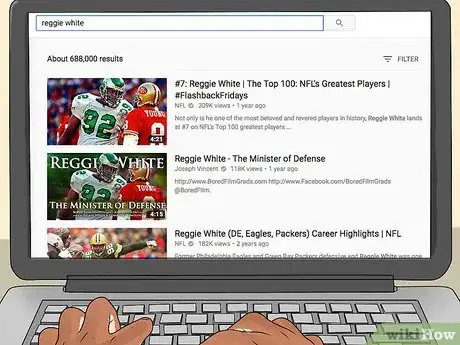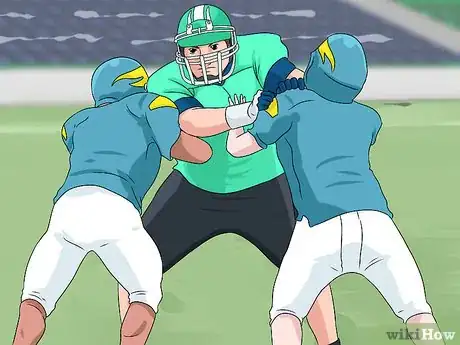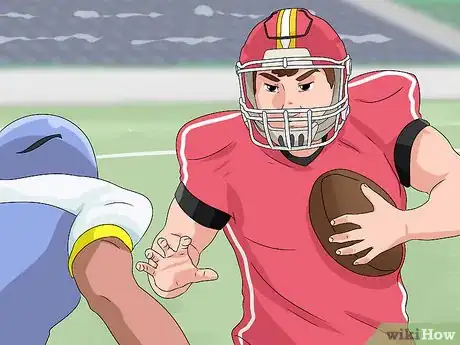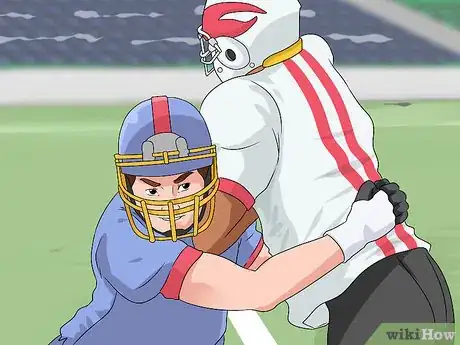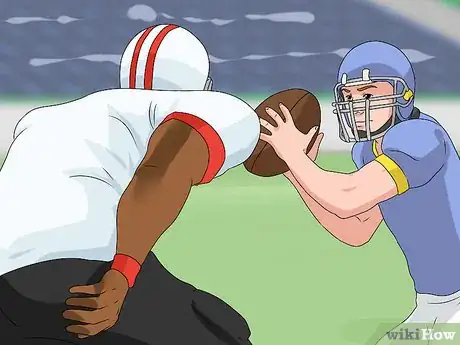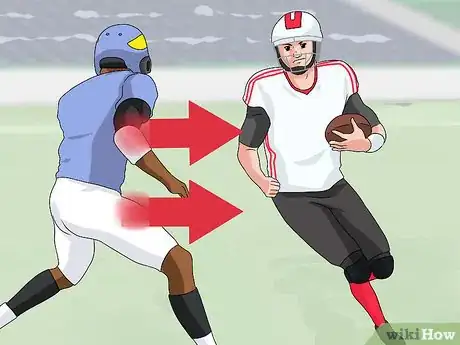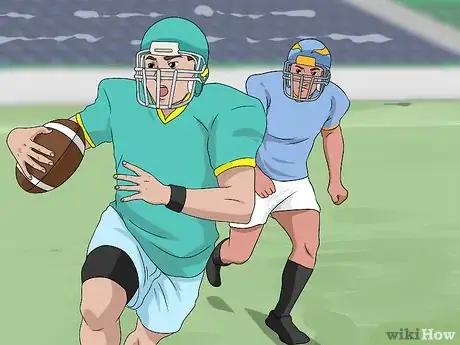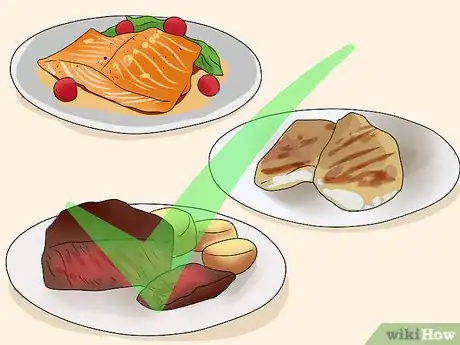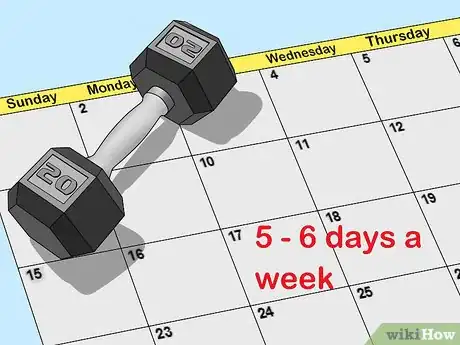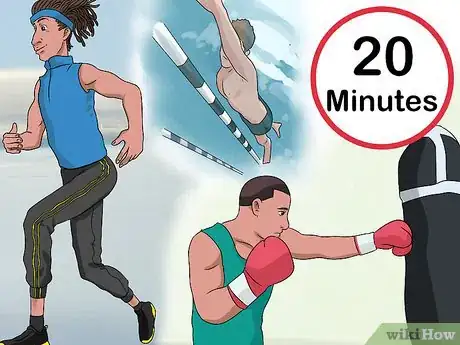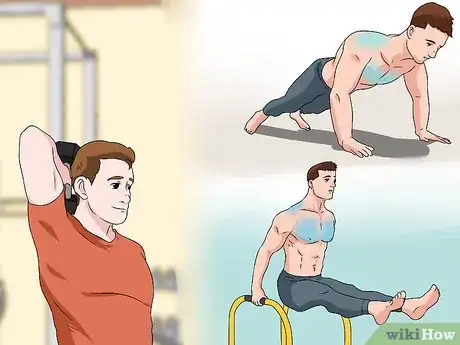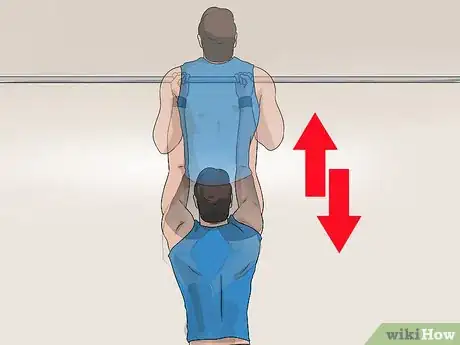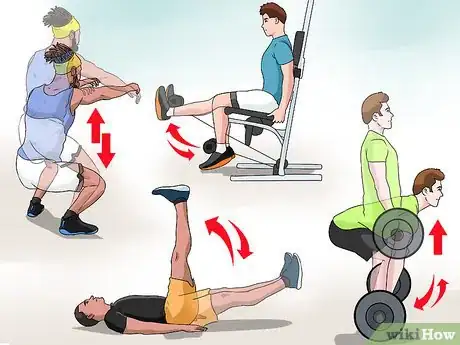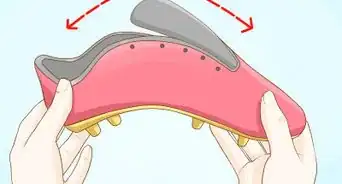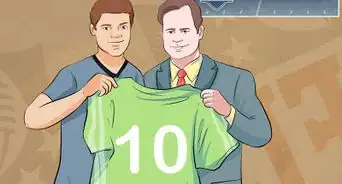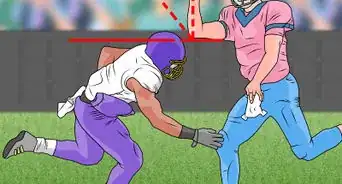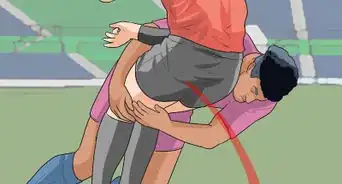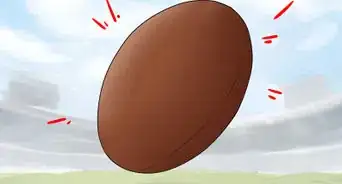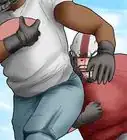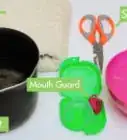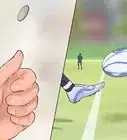This article was co-authored by wikiHow Staff. Our trained team of editors and researchers validate articles for accuracy and comprehensiveness. wikiHow's Content Management Team carefully monitors the work from our editorial staff to ensure that each article is backed by trusted research and meets our high quality standards.
There are 9 references cited in this article, which can be found at the bottom of the page.
wikiHow marks an article as reader-approved once it receives enough positive feedback. In this case, 90% of readers who voted found the article helpful, earning it our reader-approved status.
This article has been viewed 213,483 times.
Learn more...
Coaches are always on the lookout for good defensive ends. Defensive ends are expected to be powerful and muscular while still being quick and nimble. To grow as a player, you'll spend a lot of time exercising. Defensive ends are also very aware on the field, so identify your opponent's plays and shut them down. Do well and you'll become a team leader that your coach and teammates depend on to strike fear in the minds of opposing offenses.
Steps
Practicing for the Game
-
1Master the three-point stance for most plays. For the three-point stance, bend at your waist. Only the hand closer to the inside of the field goes on the ground. Bring your knees close to the ground so that your back is flat and then lift your head towards the opposing team. You'll feel balanced and ready to spring towards any direction.[1]
- This stance is the most common one for defensive ends because it can be adapted for all situations.
-
2Practice the four-point stance for pass plays. In the four-point stance, both of your hands go on the ground. Spread your feet and squat down. Lean forward so your legs are behind you and your back is flat. When you pick your head up, you'll feel ready to charge forward with power.
- The four-point stance is best for pass plays because all you do is go forward to move the lineman to get to the passer.
Advertisement -
3Study the coach's basic defensive scheme. The job of the defensive end is relatively simple on paper. You'll be at one end of the field lined up against either the tight end or a lineman. When the ball is snapped, you make contact with the player that opposes you. For defensive ends, all schemes operate the same way, so work with the coach to find out who they want you to cover.[2]
- A 4-3 defense has one more defender at the line of scrimmage than a 3-4, but you'll be up against a lineman in both schemes.
-
4Practice regularly with your team. Becoming a better player only happens through lots of practice. Practice is where you'll master techniques, stay in shape, and get experience reading an opposing offense. You'll need to practice with the rest of the defense to become a unit that works well together on the field.
-
5Watch game film of defensive ends. A simple search online will provide you with plenty of official game film. You can watch Reggie White, considered to be one of the best players ever, or J.J. Watt, among others. Pay attention to how they line up and react to the changing situations during the course of a play. You might learn a trick that will help you out in a game.
-
6Study the opposing offenses. Spend your time watching any game footage you can find. Some games are broadcast online or on local TV. Go out and watch as many live games as you can. Focus on how the offense moves and what kind of plays they run so you have an idea of how to beat them in your next game.
Playing Well in a Game
-
1Watch for tells that give away the offensive playcall. It's not a random guess here. The offensive linemen often give away the play through their body language. A split between two linemen might show you where the ball will go. They might also point their bodies in the direction they'll try to push you. A relaxed stance might indicate the play will be on the other side of the field.[3]
- Look at the stances. A two-point stance is a pass play, and a three-point stance may be a run play.
-
2Attack the lineman's outside shoulder after the snap. As soon as you see the snap, you charge forward. Hit the opposing lineman or tight end on the outside edge. If they manage to turn you towards the inside of the field, the quarterback (QB) or running back (RB) will see daylight to your side. Stay low and fight the block as you watch the play develop.[4]
- Tackling technique is learned during practice, but remember that that a tackling dummy won't try pushing you to the inside.
- Don't try to guess where the ball is going. Instead, make contact first and stay alert.
-
3Extend your arms after contact. When you first collide with the lineman, push away from them but don't let them go. Usually they'll be absorbed with keeping you still. Separating yourself a little gives you some room to spot where the ball is going. Since you're still in the way, the runner will have to decide how to get around you, but you'll be ready to chase them.[5]
-
4Keep your head up as the play develops. When you're busy tackling your opponent, you'll feel tempted to put your head down and use your strength. A good defensive end has to pick their head up and find the ball. Then you can turn around and help your teammates until the play is finished.
- This is especially important when the lineman lets you get by too easily, which signals a screen pass (quick pass) or draw play (run that looks like a pass).
-
5Stay on your side of the field to stop running plays. Overeager defensive ends focus only on getting to the QB. When you cross the line of scrimmage, you abandon your side of the field. It won't take long for a RB to reverse course and get past you for a big gain. Hold your position until you're sure it's a passing play or that the runner is trapped.[6]
-
6Get in the way of passing lanes. If the QB looks in your direction, the ball might come past you. Positioning yourself in the QB's line of sight while keeping your arms up obstructs passing lanes. If you managed to get by the lineman, get up in the QBs face. Stay ready to knock down any pass you see or at least delay the throw long enough that the other defensive end has a chance to make the tackle.
-
7Force the QB towards the inside of the field. When you get a chance to sack the QB, don't go straight for them. Curve around from the side. The QB is less likely to see you coming when you do this. If you let a mobile QB get to your outside, they can blow past you for a big gain. It's better to force them to go towards the center of the field where most of your teammates will be.
-
8Chase the ball even when it gets past you. Never give up on a play. The runner might cut back towards you or drop the ball. Even if you make a mistake or aren't involved in the initial play, you're still important on the field. Use that endurance you built up to get down the field until the referee blows the whistle. All it takes is one mistake from your opponent for you to become the hero.[7]
Caring for Your Body
-
1Eat healthy foods to gain muscle. Defensive ends need to be strong in order to get past the offensive linemen. Substituting out the sugary cereal, potato chips, and cookies for protein is the key to building muscle. Lean meats such as fish, chicken, and lean beef are all common athlete fuel. Match these with whole grains and fruits and vegetables to give you energy. Trade unhealthy drinks for whey powder to get another protein boost.[8]
-
2Spend time at the gym. If you aren't on a team with access to a weight room, join a local gym. You'll need to be there often, since defensive have to be very strong. Most home gyms don't have as many workout options as commercial gyms, where you can find trainers who can help motivate you. If you're already on a team, the coach can also help you with this.
- At a minimum, you'll need a bench press, treadmill or stationary bike, some dumbbells, and a chin-up bar to do this at home.
-
3Schedule your workout routine. Exercising all your muscles every day would burn you out. Instead, focus on a different muscle group every day. For example, spend the first day strength training your chest and shoulders. On the second day, focus on your arms and back. Dedicate the third day to your legs. Complete cardio exercises as much as you can during these days.[9]
- Overall, aim to exercise five or six days a week.
- Sticking to a routine is tough, and you'll have to dedicate your free time to it. Don't give up, though. You'll be grateful you stuck with it when you're quicker and stronger.
- Coaches and personal trainers can help create a routine that's right for you.
-
4Start out with a cardio workout. Cardio should be done everyday. No matter what muscles you train, start off with a 20 minute cardio warmup. Mix in longer cardio exercises when you're finished lifting weights. Cardio is what builds your stamina so you aren't panting after a brief clash with the linemen. It's also crucial to building the quickness that gets you to the quarterback.[10]
- A warm up exercise can be running on the treadmill, going for a jog, or using a stationary or real bike.
- Longer exercises are 40-yard sprints, hitting a heavy bag, or swimming laps.
-
5Strengthen your chest and shoulders. Some workouts for these muscles are the bench press, shoulder press, triceps extensions, shrugs, push ups, and dips. As a defensive end, you want to pack muscle in your upper body, so try picking a heavier weight and doing less repetitions. If you get tired and need to lower the weight, do it to avoid injury.[11]
-
6Exercise your upper back and arms. Some workouts for these muscles include the row, pull-downs, chin ups, bicep curls, and wrist curls. Balance the number of sets and repetitions with the amount you do for the rest of your upper body. Arm strength is useful for grappling with offensive linemen as well as corralling RBs trying to dash down your side of the field.
-
7Train your lower body for strength and speed. Defensive ends are all-around players, so you need to keep your upper and lower body equally strong. Good lower body workouts include crunches, squats, deadlifts, leg lifts, leg extensions, leg curls, leg presses, and calf raises. Exercises such as the pyramid box jump and three cone crossover can give you a speed boost as well.
- Cross phasing is also a key part in being a defensive end. Cross phasing is when you establish your contact and throwing him off you if you know where the ball is. Say you establish your contact on someone, if the play is coming to your side, throw him the opposite way and run to the ball
Community Q&A
-
QuestionHow do I contain really well?
 DonaganTop AnswererYou train really hard so that you're bigger and stronger than the guy trying to block you.
DonaganTop AnswererYou train really hard so that you're bigger and stronger than the guy trying to block you. -
QuestionWhat if I am only 5 ft tall and about to play as a freshman?
 Community AnswerYour height does not matter. Some people have played varsity football at 4'10". Just stay healthy and in good shape and work on your skills as much as possible. You'll get bigger soon.
Community AnswerYour height does not matter. Some people have played varsity football at 4'10". Just stay healthy and in good shape and work on your skills as much as possible. You'll get bigger soon. -
QuestionWhat weight should I be?
 Community AnswerFigure out your height and body mass. You want to have equal amount of fat compared to bones. Talk to a doctor or weight specialist and determine whether you need to lose weight or not. Age is another factor.
Community AnswerFigure out your height and body mass. You want to have equal amount of fat compared to bones. Talk to a doctor or weight specialist and determine whether you need to lose weight or not. Age is another factor.
References
- ↑ http://www.active.com/football/articles/the-3-stances-of-offensive-linemen
- ↑ https://football.calsci.com/DefensiveLine.html
- ↑ http://www.dummies.com/sports/football/defense/what-makes-a-good-defensive-lineman-in-football/
- ↑ https://www.thoughtco.com/how-to-play-defensive-end-1336336
- ↑ https://www.coachup.com/nation/articles/tips-for-a-defensive-end
- ↑ https://www.bigcatcountry.com/2013/6/15/4417586/cover-3-defense-run-stopping
- ↑ https://www.coachup.com/nation/articles/tips-for-a-defensive-end
- ↑ https://breakingmuscle.com/healthy-eating/top-10-foods-to-gain-muscle-mass
- ↑ http://www.athleticscholarships.net/2012/04/13/college-football-defensive-lineman.htm

